If and when we send colonists to Mars and beyond, we’re going to need habitats unlike any we’ve built before. To encourage out-of-the box thinking, NASA and America Makes are kicking off a $US2.25 million dollar competition to design and build 3D printed space habitats.
Image: Interstellar Mayflower, art by Stephan Martiniere
One of the biggest barriers to the construction of a space colony is shoring up the money to ship the building materials we’ll need. Since it currently costs roughly $US10,000 to blast a kilogram of anything off our planet, scientists, engineers and entrepreneurs have been asking how we might get away with less cargo. Indeed, that’s one of the main thrusts behind asteroid mining, which could offer spacefaring humans a bountiful supply of water and metals.
Other technologies that take advantage of in situ resources have been discussed in the context of a Martian habitat, but so far, the focus has been on how we might get enough water to drink and oxygen to breathe. While these are vital pieces of the puzzle, we could save ourselves a lot of money and effort if we were able to manufacture infrastructure using indigenous materials as well.
Which is where the new competition comes in. While some money is being offered for just plain awesome architectural concepts, the lion’s share of the prize pot focuses on the 3D printing technologies needed to fabricate infrastructure from in situ materials and recyclables.
NASA breaks it down for us:
The first phase of the competition, announced Saturday at the Bay Area Maker Faire in San Mateo, California, runs through Sept. 27. This phase, a design competition, calls on participants to develop state-of-the-art architectural concepts that take advantage of the unique capabilities 3-D printing offers. The top 30 submissions will be judged and a prize purse of $US50,000 will be awarded at the 2015 World Maker Faire in New York.
The second phase of the competition is divided into two levels. The Structural Member Competition (Level 1) focuses on the fabrication technologies needed to manufacture structural components from a combination of indigenous materials and recyclables, or indigenous materials alone. The On-Site Habitat Competition (Level 2) challenges competitors to fabricate full-scale habitats using indigenous materials or indigenous materials combined with recyclables. Both levels open for registration Sept. 26, and each carries a $US1.1 million prize.
So, if you’ve always thought you had a brilliant idea for how to build a Martian city or a deep space generation ship, now’s your chance to find out. Worst case scenario, you come up with a cool concept. Best case, you become the architect or engineer behind humanity’s first outer space colony, with generations of Martians and Alpha Centaurians singing your praises. Doesn’t sound too bad either way.
[NASA]
